Pro Trails at Gravity Logic
23 May 2013
By David Scorer
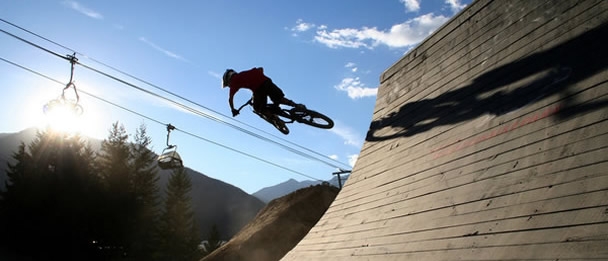
Given the evidence, it's kind of apt, a name like that. Tom 'Pro' Prochazka. As one third of the founding members of Whistler Gravity Logic, these guys have been designing and buidling 'professional' bike trails for years now. And we're not talking just any trails here, with average rider numbers. Their trails have developed reputaions all of their own in the mountain bike world. Trails so super fun that everyone is stoked to ride them. These are the trails that riders demand to ride; a 'closed for maintenance' sign just does not cut it - they must be capable of taking a sustained beating from constant 2 wheeled traffic. So it's fair to say that it takes a 'Pro'. Check out the Gravity Logic promo vid cos it's cool, and then see what Tom had to say...
A short sample of some of the trails that we've designed and/or built. Thanks to all the filmmakers and resorts that shared their footage!
WBP: Thanks for taking time out to chat to us - appreciate your schedule is pretty packed. I know you’re racking up the air-miles - how many different countries or locations has WGL been in since the start of this year!?
TP: Canada, US and Sweden so far. If a US state counted as a country then it would be more – Oregon, California, Wisconsin, Virginia, West Virginia and Vermont, Colorado soon.
WBP: How exactly did you get in to the business of building bike parks?
TP: My partners (Dave Kelly and Rob Cocquyt) and I worked in the Whistler Mountain Bike Park in the early days and we had to deal with a lot of people coming from all over the world to see what we were doing and that was taking a lot of our time. Due to that strain, we decided to start a consulting company and Gravity Logic was born in 2005. A lot of support at that time came from Rob McSkimming (the Big Bike Park Boss at Whistler) and Whistler/Blackcomb as GL was part of W/B until 2007. Dave, Rob and I bought the company in 2007 from W/B and have been independent since then. We are using the knowledge gained building the Whistler Mountain Bike Park to develop successful bike parks around the world.
WBP: How long has WGL been going now and how has the team grown since you started.
TP: GL has been around since 2005. Although our principal team has remained the same, Dave, Rob and I, we added a team of trail builders that we have worked with at different bike parks and Paul Mutch who is an expert in the Rental/Retail/Programs department. Our team now has the expertise to not only design and build quality trails, but also to create a business plan that will ensure long term financial success for our clients.
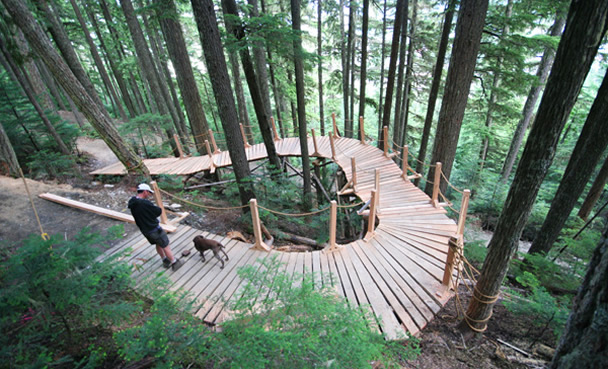
The bridge switch-back on Crank It Up at Whistler Bike Park.
WBP: What was it like in the early days of Whistler Bike Park, and to what extent are you still involved in the trail development there?
TP: The early developments of the WMBP were memorable days; because we were growing exponentially and were building new trails all of the time. The development inspiration came from the heart and gut feeling, not a lot of science. Our crews were super tight, almost like a family and we were creating fun trails – A-Line, Dirt Merchant, Crank It Up, Schleyer, In Deep, O’ Sin etc. We have been working closely with the WMBP ever since leaving in 2007, mostly creating future master plans, but we did design and build the Top Of The World trail off the Peak of Whistler. That was a great opportunity to create something special in our back yard.
WBP: In your opinion, what are the most important factors of a good bike park?
TP: The trails are the back bone of any bike park. They have to be well designed, sustainable and have to cater to all rider abilities. A lot of bike park revenues come from the beginner/intermediate rider segment in the form of rental and guiding services. These riders must have a positive experience to stay in the sport and translate into return visits for the resort (or other resorts). If the trails are too difficult or damaged then the resort can’t cater to the beginner/intermediate market and will miss out on a huge portion of potential revenue. A good bike park also has to have a good offering of advanced and expert trails to keep the core riders happy and coming back for more. The fact is (like it or not) that excavated jump trails like A-Line, Dirt Merchant and Crank It Up are the “money” trails and every successful bike park should have at least one (or two, or three). These trails attract riders because they are not common except in bike parks, and they are fun to ride.
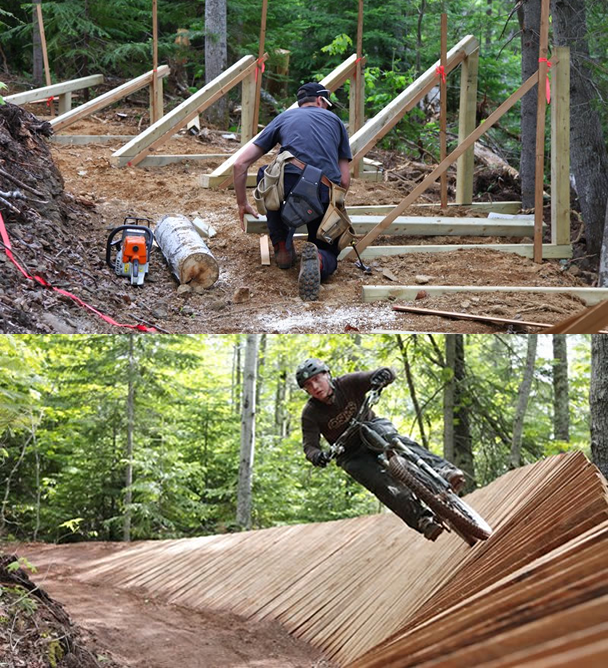
Special heat-treated pine used at Sugarloaf Bike Park in New Brunswick - more resistant to rotting.
WBP: What are some of the practical challenges you face when putting in a new trail?
TP: It all depends where you are. In some locations it may be land use issues, in others it may be geographical (terrain) issues or it may be geological (dirt) issues. Or it may be a combination of all. It does not matter what challenges we are dealing with we always want to build the best possible trail under the circumstances. If the challenges are such that a quality trail is not possible we will let our client know so that their investment is not wasted. Most of the time, we can come up with some kind of a solution to get the job done. All of the challenges we have faced have turned into learning opportunities for us and our clients.
WBP: What’s your best piece of work - the trail, trail section or feature that you’re most proud of and look back on to try and replicate when starting something new?
TP: All three of us always refer to the trails we have built in the WMBP, but we have had new opportunities to build trails elsewhere using new technology (Engcon Rototilt Excavator Attachment) , so we do have some personal favorites outside of Whistler. Pretty much any bike park we have worked at we can name something that is our personal favorite, but that would make it too many to name.
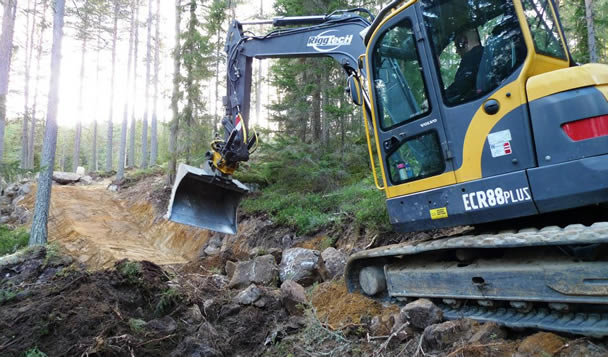
Moving serious dirt for the Twist Twist trail at Jarvso in Sweden.
WBP: You’ve now worked on big projects on both sides of the Atlantic. Are there any differences in trail design and bike park development on either side of the pond?
TP: The trail design remains the same all over the world, but logistical challenges differ from country to country. Sweden is much like Canada where there are not many land use constraints and on the ground decisions generally translate into trails quickly. Lower Europe suffers from land use issues because a resort property may have multiple land owners who may not share positive views on a bike park operation causing the bike park to be fragmented. Any resort located on public lands in the US falls under the USFS (US Forest Service) jurisdiction and the NEPA (National Environment Protection Agency) project approval process. This can be lengthy and costly, but as more bike parks are built properly, even this process is becoming more streamlined. Each country’s challenges have taught us valuable lessons that help us in future projects.
WBP: Is there a market that you’re particularly keen to break in to, that you think is primed for bike park development on a major scale - South America maybe?
TP: We would really like to do something special in lower Europe – Germany, Austria, Italy, Switzerland or France. There are many resorts and a lot of riders there but no real quality bike parks. That is a huge untapped potential. Also, England comes to mind, but they lack the ski resorts, so it would be a bit more challenging to build the standard bike park model. When China happens it will be huge.
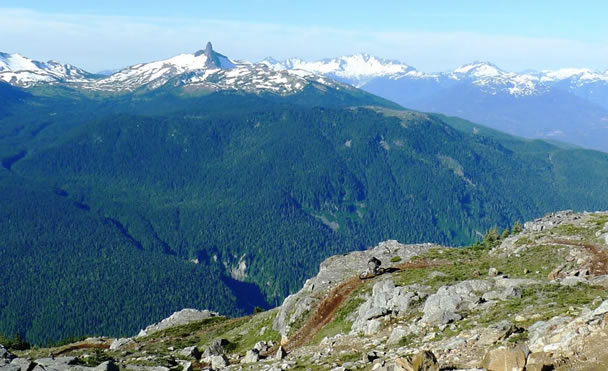
Top of the World trail at Whistler - why would you want to be anywhere else!?
WBP: Do you see any emerging trends in the style of trails, features and overall bike park design, or is it generally just the bigger the better?
TP: I don’t think that bigger is necessarily better because that does not get new riders into the sport. We are seeing new development in the all mountain lift assisted experience – take your AM bike up the lift and ride flowy single track down. Not all riders want to ride DH rigs and spend all of their time riding a bike park. But when they do, they want to bring their AM bikes to ride suitable trails. That is why the Top Of The World trail at Whistler has been so popular with all level of riders. We have also had great success with innovative excavated trails in Sweden and Colorado, but I would not call that a new trend, more like a progression. In general, more people want to ride a smaller bike and want suitable trails to ride on. Any trail, beginner to expert, that flows will be popular.
WBP: Finally, you’ve seen many of the best mountain bike locations in the world. If you were to ‘retire’, to live anywhere you like based on the quality of the trails, then where would that be?
TP: Luckily I live in Whistler so I won’t have to move when I retire, which won’t be anytime soon. Everywhere I go I find something beautiful and fascinating, but Whistler has the whole package – winter and summer. I do enjoy visiting other places and making new friends though.
Interview by David Scorer
May 2013
www.whistlergravitylogic.com

Comments